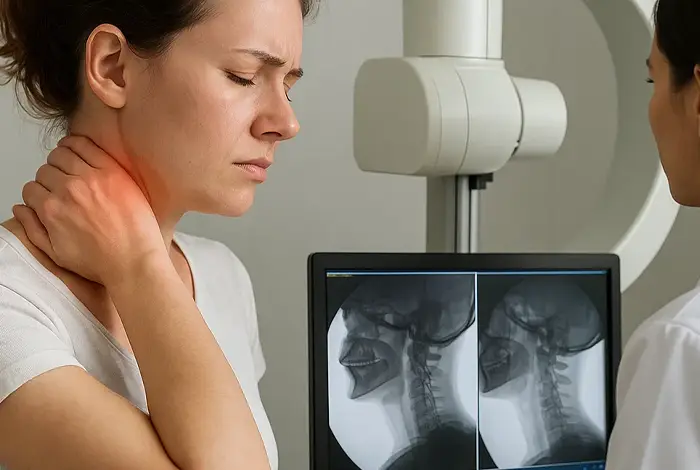After a low-speed “fender bender,” you’re told the car looks fine and your ER X-rays are normal. Days later, the headaches start. Weeks later, your neck aches, sleep suffers, and driving becomes tense. Months later, you feel “unstable” turning to check a blind spot. If this sounds familiar, the missing piece may be ligament injury structural damage that doesn’t show up on routine scans because it’s positional and movement-dependent. Digital Motion X-Ray (DMX) is designed to find exactly that.
Why minor collisions can produce major neck problems
Even at 5–10 mph, rapid acceleration deceleration can stretch the alar, transverse, and capsular ligaments faster than muscles can protect you. The head whips forward/backward or side-to-side in milliseconds. No fracture or disc herniation is required for symptoms to be real. Subtle micro-instabilities between vertebrae may:
- Disrupt joint mechanics, creating persistent stiffness and pain.
- Irritate nearby nerves and trigger headaches or jaw tension.
- Force muscles to guard constantly, driving fatigue and limited range.

Why routine imaging misses it
ER X-rays and many MRIs are static you’re lying down or standing still. But ligament injuries often appear only in motion, especially with rotation, extension, or lateral bending. Without a moving study, the structural cause is easy to miss, and symptoms get mislabeled as a generic “strain” that should resolve.
How DMX clarifies post-accident cases
DMX captures real-time fluoroscopic video while you perform gentle, guided movements. Clinicians analyze for:
- Excessive gapping/translation between bones (instability).
- Levels that slip when loaded but look normal at rest.
- Compensation patterns that match your symptoms (e.g., dizziness when turning).
This objective, visual evidence can guide care more precisely and, when needed, document injury for legal or insurance purposes.
Case snapshot
“Carlos,” rear-ended at a stoplight, had ongoing neck pain and headaches despite normal ER films. DMX revealed C1–C2 instability during rotation and C4–C5 issues with extension exactly when his symptoms spiked. With regenerative ligament care, specific adjustments, and vestibular-informed rehab, he returned to comfortable driving and full work days over several months.
What treatment looks like after DMX
- Regenerative injections (PRP/cellular) to tighten specific ligaments.
- Precision chiropractic procedures that avoid over-mobilizing lax segments.
- Neuromuscular retraining integrating head/eye/vestibular control.
- Postural and graded activity to rebuild confidence and endurance.
Who should consider DMX after a “minor” crash
- Lingering neck pain, headaches, dizziness, or jaw issues with normal MRI/X-rays.
- A sense of neck “instability” or fear with turning/merging.
- Symptoms that flare in specific positions but not at rest.
Miami access, bilingual clarity
In Miami, where crashes are common and international travel is easy, patients from Central and South America and the Caribbean rely on DMX when routine workups fall short. Our bilingual team (English/Español) ensures you and your family fully understand the findings and next steps.
Call 305-275-7475 or book your appointment online

Dr. Rodolfo Alfonso, D.C.
Dr. Mark N. Berry, D.C.
Sunset Chiropractic and Wellness
8585 Sunset Dr. STE 102
Miami, Florida 33143
305-275-7475
Schedule Your DMX Today
You’ve been searching for answers. Now you can see the cause of your symptoms in motion.
Visit us in Miami
Call 305-275-7475
Request an appointment online
Follow us on Instagram, Facebook, and YouTube for updates, patient success stories, and expert insights on neuropathy treatment!
